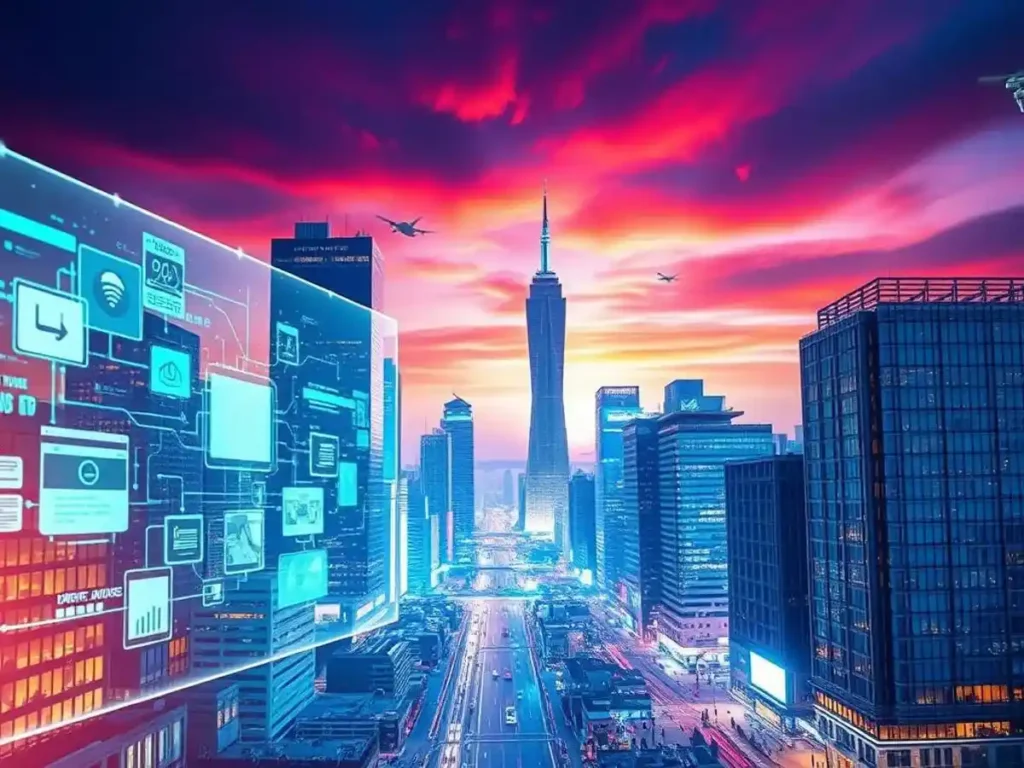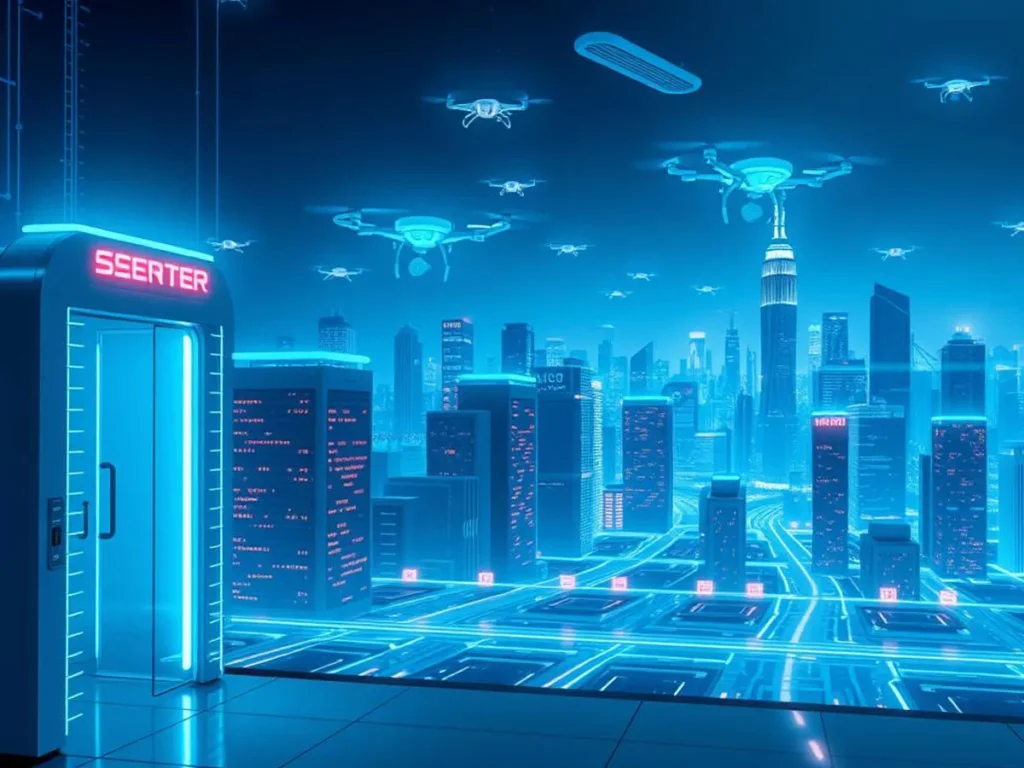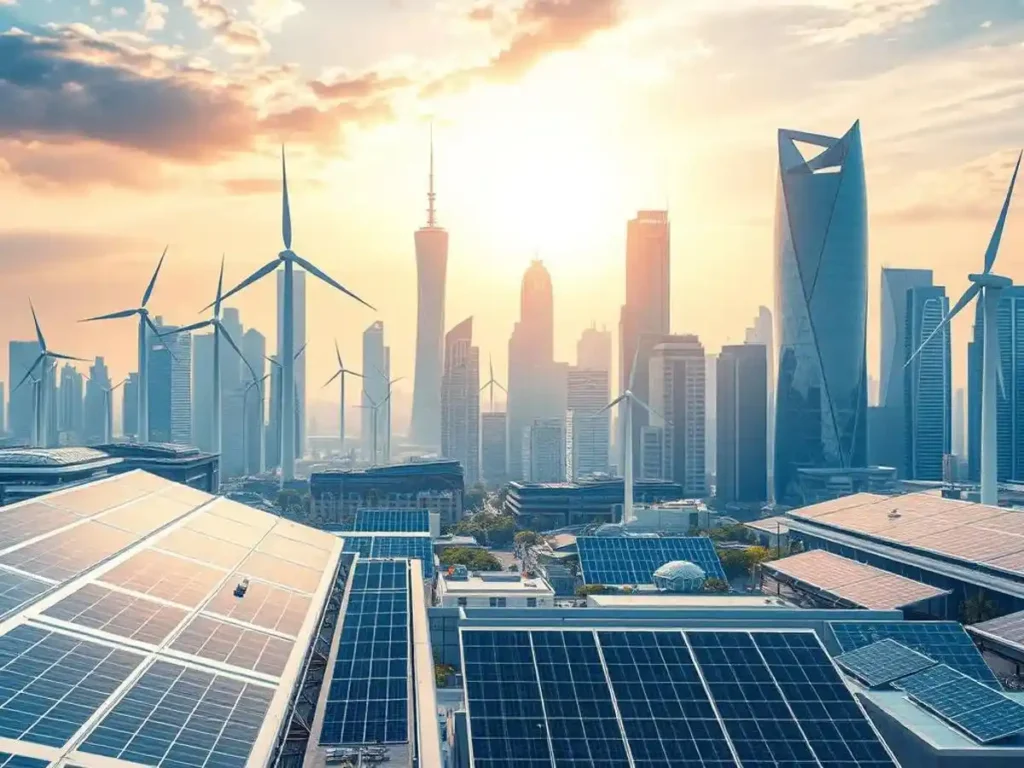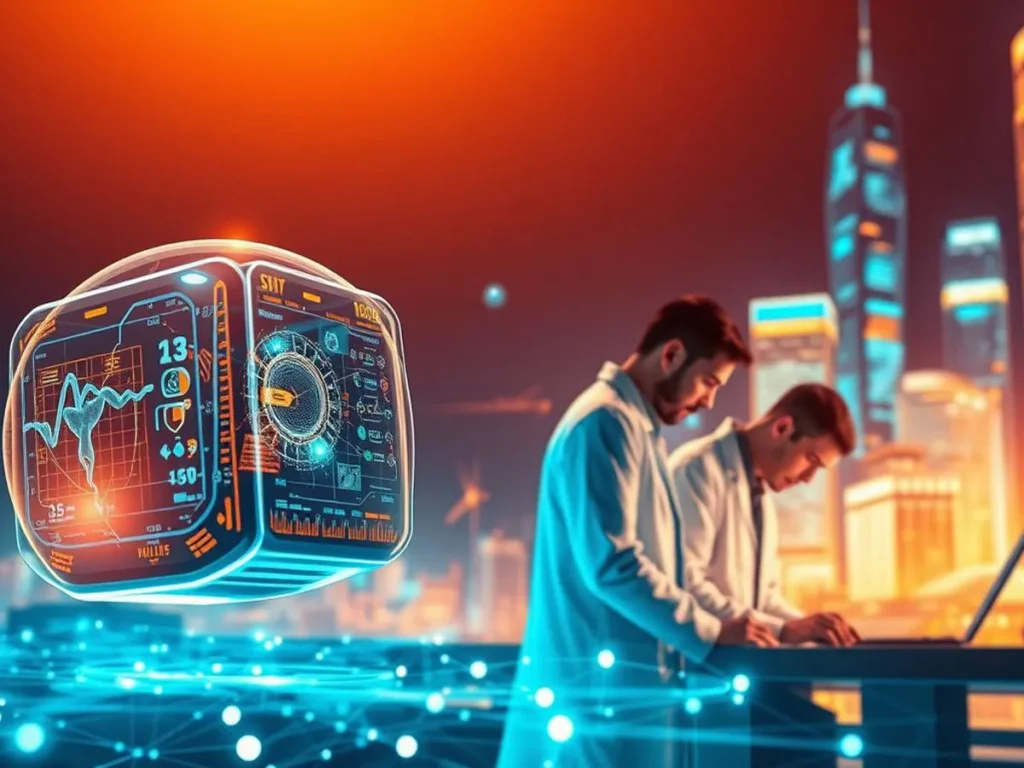As we get closer to 2025, the world of digital transformation strategies is changing fast. But what will lead to this change?
Will new technology trends change how businesses work and societies live? The answer is in the top trends that will shape our future.

The next year will see big steps forward in many areas, thanks to new digital transformation strategies. Looking at the top 10 technology trends of 2025, it’s clear they will deeply affect both businesses and society.
The Digital Revolution Accelerates in 2025
The digital world is changing fast in 2025, thanks to AI and machine learning. Artificial intelligence advancements help businesses automate tasks, making them more efficient and saving money. Machine learning applications are getting better, leading to more accurate predictions and smarter decisions.
As tech keeps getting better, companies are using these tools to stay ahead. AI and machine learning are making operations smoother and sparking new ideas. They’re changing how we work in fields like healthcare and finance, opening up new chances for growth.
By using artificial intelligence and machine learning, businesses can lead the digital change. They’ll be ready to grab new chances as they come.
Understanding Key Technology Trends 2025: A Strategic Overview
It’s key for businesses to know the main tech trends of 2025. Technology is changing fast, and spotting important trends is crucial.
The technology trends 2025 will be influenced by big leaps in AI, quantum computing, and extended reality. These areas will blend, opening up new chances and hurdles for companies.
These trends could change many industries. For example, AI-powered decision-making systems could make businesses more efficient and competitive.
The future of cybersecurity is also a big deal in 2025’s tech trends. With tech getting better, cyber threats are getting smarter too. So, companies need to focus on strong security.
In short, knowing the main tech trends of 2025 is essential for businesses. It helps them adapt to changes and grab new chances.
1. Artificial Intelligence Revolution
In 2025, the AI revolution is speeding up in many areas. Artificial intelligence advancements are making old processes better and starting new ones.
Generative AI and Creative Applications
Generative AI is a big deal now, especially in art, music, and content creation. It uses machine learning algorithms to create new stuff from what it’s learned.
AI-Powered Decision-Making Systems
AI is helping companies make better decisions and plan smartly. These systems look at lots of data to give insights for business choices.
Enterprise AI Implementation Strategies
Putting AI in businesses needs a good plan. Companies are working on strong data setups and big AI solutions.
Ethical Considerations in AI Development
As AI spreads, thinking about ethics is more important. Developers are working on making AI systems clear and fair.
| AI Application | Industry Impact | Benefits |
|---|---|---|
| Generative AI | Creative Industries | Enhanced creativity, Automated content generation |
| AI-Powered Decision Making | Enterprise Operations | Improved efficiency, Data-driven decisions |
The future of AI looks bright, with chances in many fields. As machine learning applications grow, we’ll see big changes in business and tech use.
2. Quantum Computing Breakthroughs
Quantum computing is moving fast, bringing us closer to a future full of possibilities. This section looks at the big steps in quantum computing. We’ll see how it’s being used in business and with machine learning.
Commercial Quantum Computing Applications
Commercial quantum computing is changing the game for many industries. It can solve problems that were too hard before. Companies like IBM and Google are leading the way, offering quantum services to businesses.
Quantum Machine Learning Integration
Quantum computing and machine learning are coming together in exciting ways. This mix could make AI systems work faster and better.
Industry-Specific Quantum Solutions
Quantum computing is being shaped for different industries. For example, in healthcare, it can help find new drugs by studying how molecules work together.
Quantum Computing Hardware Advancements
Improving quantum computing hardware is key for real-world use. New breakthroughs in qubit stability and error correction are making quantum computers more reliable.
| Industry | Quantum Computing Application | Potential Impact |
|---|---|---|
| Healthcare | Drug Discovery | Accelerated development of new medicines |
| Finance | Portfolio Optimization | Improved investment strategies |
| Logistics | Route Optimization | Reduced transportation costs |
As quantum computing grows, we’ll see more cool uses in different fields. It will change how businesses work and open up new chances for growth.
3. Extended Reality (XR) Ecosystems
It’s changing many parts of our lives. XR technologies are making immersive experiences that change industries and how we use digital information.
Virtual Reality in Professional Training
Virtual Reality is becoming popular for professional training. For example, VR helps train surgeons and pilots.
Augmented Reality for Consumer Applications
Augmented Reality adds digital info to the real world. It’s used in retail to let customers see products at home. It also makes gaming and entertainment more interactive.
Mixed Reality in Healthcare and Education
Mixed Reality is big in healthcare and education. It offers interactive learning. In healthcare, it helps with surgical planning and patient education. In education, it makes learning fun and interactive.
XR Hardware Evolution
The growth of XR hardware is key to its adoption. New hardware makes devices more advanced and easier to use. Here are some important XR hardware updates.
| XR Hardware Component | Current Advancements | Future Prospects |
|---|---|---|
| Display Resolution | Higher resolution displays for clearer visuals | Advancements in micro-LED technology |
| Tracking Systems | Improved inside-out tracking for better mobility | Integration of AI for more accurate tracking |
| Controllers | More intuitive and gesture-based controllers | Development of haptic feedback technology |
As XR grows, we’ll see new uses in many fields. This will push digital transformation strategies and use Internet of Things innovations.
4. Next-Generation Cybersecurity Frameworks
New cybersecurity frameworks are key for today’s security plans. As cyber threats grow, companies are using advanced methods to keep their data safe.
The move to next-generation security is urgent. It’s needed for stronger, flexible security. This includes zero-trust architecture, which sees threats from both inside and outside the network.
Zero-Trust Architecture Implementation
Zero-trust architecture checks all users and devices trying to get into the network. It cuts down on data breach risks by stopping threats from spreading.
AI-Powered Threat Detection Systems
AI-powered threat detection systems are also crucial. They look through lots of data to spot unusual patterns. This helps find threats quickly and accurately.
Quantum-Resistant Cryptography
With quantum computing on the rise, quantum-resistant cryptography is essential. It creates algorithms that can’t be broken by quantum computers. This keeps sensitive data safe for the future.
Cybersecurity Talent Development
Next-generation security also relies on skilled cybersecurity teams. Companies need to train and improve their teams to tackle new threats and tech.
| Cybersecurity Measure | Description | Benefits |
|---|---|---|
| Zero-Trust Architecture | Requires verification for all users and devices | Minimises risk of data breaches |
| AI-Powered Threat Detection | Analyses data to identify patterns and anomalies | Faster and more accurate threat detection |
| Quantum-Resistant Cryptography | Develops algorithms to withstand quantum attacks | Ensures long-term data security |

5. Internet of Things (IoT) Evolution
The Internet of Things (IoT) is changing how industries and markets work. IoT innovations are leading to new uses and better efficiency.
Smart Cities Infrastructure Development
IoT is making a big difference in smart cities. It helps create better infrastructure, like smart traffic systems and energy grids.
Industrial IoT Applications and Analytics
In factories, IoT boosts efficiency and cuts costs. It uses sensors and analytics for maintenance, quality checks, and supply chain management.
Consumer IoT Privacy and Security
IoT devices in homes raise privacy and security worries. Makers need to focus on secure devices and teach users how to protect their data.
IoT Standards and Interoperability
The IoT world faces a big challenge: standardising devices. Work is underway to create common standards for easy communication between devices.
As IoT innovations keep growing, we’ll see more exciting uses. The future of IoT looks bright, with big chances in healthcare, transport, and energy.
6. Sustainable Technology Solutions
Sustainable technology is key in digital transformation strategies. It helps companies cut down on environmental harm. Using green tech makes operations more efficient and saves money.
Green Computing and Data Centre Efficiency
Green computing aims to lessen computing’s environmental harm. Data centres, big energy users, are getting more efficient. They’re using solar power, better cooling, and smart server use to cut down on emissions.

Renewable Energy Tech Integration
Using renewable energy technologies is vital. Companies are moving to solar and wind power to cut fossil fuel use. This move cuts down on emissions and offers a green energy source.
Carbon Footprint Monitoring Technologies
Tracking the carbon footprint is crucial for reducing harm. Carbon footprint monitoring technologies help companies see where they can improve. This info guides them to lower their environmental impact.
Circular Economy Digital Platforms
Digital platforms support a circular economy. They help share, reuse, and recycle, cutting down waste. This approach benefits both the planet and a company’s finances.
7. Advanced Robotic Automation
Advanced robotic automation is changing how we make things, move goods, and offer services. Robots are getting smarter and can do complex tasks well. They work fast and accurately.
Autonomous Robots in Manufacturing and Logistics
Autonomous robots are becoming popular in making things and moving goods. They help make production and supply chains better. These robots can work all day, every day, without getting tired. This makes things more productive.
Key Applications:
| Industry | Application | Benefits |
|---|---|---|
| Manufacturing | Assembly Line Automation | Increased Efficiency, Reduced Labour Costs |
| Logistics | Warehouse Management | Improved Inventory Management, Faster Order Fulfilment |
Service Robotics in Healthcare and Hospitality
Service robots are changing healthcare and hospitality. They help with patient care and customer service. Robots do tasks like helping patients and serving in rooms.
Examples include: robotic assistants in hospitals and robotic concierges in hotels.
Human-Robot Collaboration Models
Human-robot collaboration is a big deal. It’s about how humans and robots can work well together. This teamwork is expected to make things more productive and safe.
Soft Robotics Innovations
Soft robotics is getting more attention. It uses flexible robots for tasks that need gentle handling. This is great for healthcare and food processing.
8. Biotechnology and Digital Health Innovations
The mix of biotechnology and digital health is changing healthcare in 2025. This blend is opening up new chances for treatments that fit each person’s needs. It also brings better ways to diagnose and treat diseases.
Personalised Medicine and Genomics Platforms
Personalised medicine is getting smarter with genomics platforms. These tools help doctors create treatments that match a patient’s genes. Genomics data analysis is key, making diagnoses and treatments more precise.
Advanced Wearable Health Technologies
Wearable health tech is growing fast, keeping track of important health signs all the time. These gadgets help patients get better care and catch health problems early.
AI in Medical Diagnostics and Treatment
Artificial intelligence is a big help in finding and treating diseases. AI can look through lots of medical data fast and right, helping doctors spot problems sooner. Machine learning applications in healthcare are getting wider, from looking at images to predicting health trends.
Regulatory Frameworks for Digital Health
As digital health tech grows, rules are being made to keep it safe and useful. These rules cover things like keeping data private and making sure different systems work together. Following these rules is key for healthcare providers and tech makers to gain trust and success.

9. 5G and 6G Connectivity Revolution
It’s about starting a new digital age. This change affects how businesses work, cities are built, and people connect with each other.
Ultra-Fast Network Applications
5G is already changing many industries with its fast speeds. It’s making things like better mobile internet, smart machines, and fast, reliable communications possible. With 6G, we’ll see even more amazing things that mix the digital and real worlds.
Edge Computing Integration and Benefits
It moves data and computing closer to where it’s needed. This cuts down on delays and makes things work faster, like self-driving cars and smart factories.
New Business Models Enabled by Advanced Connectivity
5G and 6G will open up new ways for businesses to grow. They’ll help in areas like smart cities and industrial IoT. This will especially help in getting internet to rural areas.
Rural Connectivity Solutions
Getting 5G and 6G to everyone is a big challenge, especially in rural areas. New tech like satellite internet and special networks are being looked at to solve this problem.
| Technology | Key Features | Potential Applications |
|---|---|---|
| 5G | Enhanced mobile broadband, low latency | Smart cities, enhanced mobile experiences |
| 6G | Ultra-high speeds, further reduced latency | Advanced IoT, holographic communications |
| Edge Computing | Reduced latency, real-time processing | Autonomous vehicles, smart manufacturing |
10. Blockchain Beyond Cryptocurrency
Blockchain technology is growing and finding new uses in many fields. It’s moving beyond just cryptocurrency, changing how different sectors work.
Decentralised Finance (DeFi) Maturation
Decentralised Finance (DeFi) is a big part of blockchain’s future. It offers services like lending, borrowing, and trading through smart contracts. This approach could make finance more accessible and cut costs.
| DeFi Platform | Features | Benefits |
|---|---|---|
| MakerDAO | Stablecoin issuance, lending | Decentralised, autonomous |
| Compound | Lending, borrowing | Algorithmic interest rates |
| Uniswap | Decentralized exchange | High liquidity, low fees |
Supply Chain Transparency Solutions
Blockchain helps make supply chains more transparent. It keeps a permanent record of transactions. This makes it easier to track goods and fight counterfeiting.
Digital Identity Management Systems
Blockchain-based systems manage personal data securely. They let people control their identity and share it safely. This reduces identity theft risks.
Government Adoption of Blockchain Technology
Governments are starting to use blockchain to improve services. They’re looking at how it can make voting systems secure and transparent. Blockchain also helps with the future of cybersecurity efforts.
As blockchain grows, we’ll see more use in various fields. It will work with quantum computing developments to bring new innovations and changes.
How to Prepare Your Organisation for Emerging Technologies
To thrive in 2025, organisations must understand and adapt to new technologies. They need to use digital transformation strategies to blend new tech with current business practices.
Developing talent is key. Companies should invest in training that boosts skills in AI, robotics, and data analytics. This helps employees work well with robotic automation trends.
Being ready with infrastructure is also vital. Organisations must check their tech setup and update it for new tech. This might mean using cloud computing, improving cybersecurity, and setting up better data systems.
Strategic planning is crucial, too. Companies should do detailed risk assessments and make plans for any challenges with new tech. This way, they can avoid problems and get the most out of these technologies.
By focusing on these steps, organisations can get ready to use new technologies and stay ahead in 2025.
Table of Contents
Conclusion: Navigating the Future Technology Landscape
The year 2025 is set to change technology a lot. This will happen thanks to big steps in artificial intelligence, quantum computing, and extended reality. We’ve seen how artificial intelligence will change many fields by making decisions better and creating new things.
Companies need to keep up with 2025’s tech trends. This includes new security systems and the growth of the Internet of Things (IoT). By using these new technologies, businesses can find new chances and grow in a digital world that’s getting more complex.
Looking ahead, being able to change and come up with new ideas is key. By taking on the latest tech trends, companies can lead their fields and do well in a world that’s always changing.
READ OUT MY OTHER BLOG POST FROM HERE

